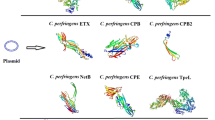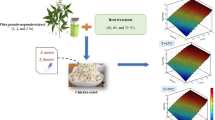Abstract
Clostridium novyi causes necrotic hepatitis in sheep and cattle, as well as gas gangrene. The microorganism is strictly anaerobic, fastidious, and difficult to cultivate in industrial scale. C. novyi type B produces alpha and beta toxins, with the alpha toxin being linked to the presence of specific bacteriophages. The main strategy to combat diseases caused by C. novyi is vaccination, employing vaccines produced with toxoids or with toxoids and bacterins. In order to identify culture medium components and concentrations that maximized cell density and alpha toxin production, a neuro-fuzzy algorithm was applied to predict the yields of the fermentation process for production of C. novyi type B, within a global search procedure using the simulated annealing technique. Maximizing cell density and toxin production is a multi-objective optimization problem and could be treated by a Pareto approach. Nevertheless, the approach chosen here was a step-by-step one. The optimum values obtained with this approach were validated in laboratory scale, and the results were used to reload the data matrix for re-parameterization of the neuro-fuzzy model, which was implemented for a final optimization step with regards to the alpha toxin productivity. With this methodology, a threefold increase of alpha toxin could be achieved.









Similar content being viewed by others
References
Amimoto, K., Noro, T., Oishi, E., & Shimizu, M. (2007). A novel toxin homologous to large clostridial cytotoxins found in culture supernatant of Clostridium perfringens type C. Microbiology-Sgm, 153, 1198–1206.
Belyi, Y., & Aktories, K. (2010). Bacterial toxin and effector glycosyltransferases. Biochimica Et Biophysica Acta-General Subjects, 1800, 134–143.
Skarin, H., Hafstrom, T., Westerberg, J., & Segerman, B. (2011). Clostridium botulinum group III: a group with dual identity shaped by plasmids, phages and mobile elements. BMC Genomics, 12, 185.
Ziegler, M. O. P., Jank, T., Aktories, K., & Schulz, G. E. (2008). Conformational changes and reaction of clostridial glycosylating toxins. Journal of Molecular Biology, 377, 1346–1356.
Wei, M. Q., Mengesha, A., Good, D., & Anne, J. (2008). Bacterial targeted tumour therapy—dawn of a new era. Cancer Letters, 259, 16–27.
Diaz, L. A., Cheong, I., Foss, C. A., Zhang, X. S., Peters, B. A., Agrawal, N., Bettegowda, C., Karim, B., Liu, G. S., Khan, K., Huang, X., Kohli, M., Dang, L. H., Hwang, P., Vogelstein, A., Garrett-Mayer, E., Kobrin, B., Pomper, M., Zhou, S. B., Kinzler, K. W., Vogelstein, B., & Huso, D. L. (2005). Pharmacologic and toxicologic evaluation of C-novyi-NT spores. Toxicological Sciences, 88, 562–575.
Brett, M. M., Hood, J., Brazier, J. S., Duerden, B. I., & Hahne, S. J. M. (2005). Soft tissue infections caused by spore-forming bacteria in injecting drug users in the United Kingdom. Epidemiology and Infection, 133, 575–582.
Batty, I., & Walker, P. D. (1964). Identification of clostridium novyi (clostridium oedematiens) + clostridium tetani by use of flourescent labelled antibodies. Journal of Pathology and Bacteriology, 88, 327.
Eklund, M. W., Poysky, F. T., Meyers, J. A., & Pelroy, G. A. (1974). Interspecies conversion of clostridium-botulinum type-c to clostridium-novyi type-a by bacteriophage. Science, 186, 456–458.
Jang, J. S. R., & Sun, C. T. (1995). Neuro-fuzzy modeling and control. Proceedings of the Ieee, 83, 378–406.
Mamdani, E. H. (1977). Application of fuzzy logic to approximate reasoning using linguistic-synthesis. Ieee Transactions on Computers, 26, 1182–1191.
Hansen, L. K., & Salamon, P. (1990). Neural network ensembles. Ieee Transactions on Pattern Analysis and Machine Intelligence, 12, 993–1001.
Zadeh, L. A. (1983). The role of fuzzy logic in the management of uncertainty in expert systems. Fuzzy Sets and Systems, 11, 197–198.
Moreno, G., & Pascual, V. (2009). A hybrid programming scheme combining fuzzy-logic and functional-logic resources. Fuzzy Sets and Systems, 160, 1402–1419.
Zadeh, L. A. (1965). Fuzzy sets. Information and Control, 8, 338–353.
Sousa, R., Jr., & Almeida, P. I. F. (2001). Design of a fuzzy system for the control of a biochemical reactor in fed-batch culture. Process Biochemistry, 37, 461–469.
Baldwin, J. F., & Guild, N. C. F. (1980). Feasible algorithms for approximate reasoning using fuzzy logic. Fuzzy Sets and Systems, 3, 225–251.
Yager, R. R. (1991). Connectives and quantifiers in fuzzy sets. Fuzzy Sets and Systems, 40, 39–75.
Lopez-Cruz, I. L., & Hernandez-Larragoiti, L. (2010). Neuro-fuzzy models for air temperature and humidity of arched and venlo type greenhouses in central mexico. Agrociencia, 44, 791–805.
Lin, C. T., & Lee, C. S. G. (1991). Neural-network-based fuzzy-logic control and decision system. Ieee Transactions on Computers, 40, 1320–1336.
Wang, L. X., & Mendel, J. M. (1992). Generating fuzzy rules by learning from examples. Ieee Transactions on Systems Man and Cybernetics, 22, 1414–1427.
Boccaletti, S., Latora, V., Moreno, Y., Chavez, M., & Hwang, D. U. (2006). Complex networks: structure and dynamics. Physics Reports-Review Section of Physics Letters, 424, 175–308.
Kourou, K., Exarchos, T. P., Exarchos, K. P., Karamouzis, M. V., & Fotiadis, D. I. (2015). Machine learning applications in cancer prognosis and prediction. Computational and Structural Biotechnology Journal, 13, 8–17.
Adeli, H., & Jiang, X. M. (2003). Neuro-fuzzy logic model for freeway work zone capacity estimation. Journal of Transportation Engineering-Asce, 129, 484–493.
Singer, T., Seymour, B., O’Doherty, J., Kaube, H., Dolan, R. J., & Frith, C. D. (2004). Empathy for pain involves the affective but not sensory components of pain. Science, 303, 1157–1162.
Jiang, X., & Adel, H. (2008). Neuro-genetic algorithm for non-linear active control of structures. International Journal for Numerical Methods in Engineering, 75, 770–786.
Lei, Y., He, Z., Zi, Y., & Hu, Q. (2007). Fault diagnosis of rotating machinery based on multiple ANFIS combination with GAS. Mechanical Systems and Signal Processing, 21, 2280–2294.
Mitra, S., & Hayashi, Y. (2000). Neuro-fuzzy rule generation: survey in soft computing framework. Ieee Transactions on Neural Networks, 11, 748–768.
Kofman, G. I., Lyssenkov, S. A. and Lobachev, R. V. (2005) Automatic creation of neuro-fuzzy expert system from online analytical processing (OLAP) tools. Google Patents
Nava, P. A., & Ieee. (1998). Implementation of neuro-fuzzy systems through interval mathematics. International Symposium on Intelligent Control - Proceedings, 1, 365–369.
Baharani, M., Noori, H., Aliasgari, M., & Navabi, Z. (2014). High-level design space exploration of locally linear neuro-fuzzy models for embedded systems. Fuzzy Sets and Systems, 253, 44–63.
Jang, J. S. R. (1993). ANFIS—Adaptive-network-based fuzzy inference system. Ieee Transactions on Systems Man and Cybernetics, 23, 665–685.
Vuorimaa, P. (1994). Fuzzy self-organizing map. Fuzzy Sets and Systems, 66, 223–231.
Ichihashi, H., Shirai, T., Nagasaka, K., & Miyoshi, T. (1996). Neuro-fuzzy ID3: a method of inducing fuzzy decision trees with linear programming for maximizing entropy and an algebraic method for incremental learning. Fuzzy Sets and Systems, 81, 157–167.
Rao, D. H., & Kamat, H. V. (1996). Neuro-fuzzy system for robotics applications. Journal of the Institution of Electronics and Telecommunication Engineers, 42, 325–333.
Nauck, D., & Kruse, R. (1999). Neuro-fuzzy systems for function approximation. Fuzzy Sets and Systems, 101, 261–271.
Shi, Z. P., & Shimizu, K. (1992). Neurofuzzy control of bioreactor systems with pattern-recognition. Journal of Fermentation and Bioengineering, 74, 39–45.
Metropolis, N., Rosenbluth, A. W., Rosenbluth, M. N., Teller, A. H., & Teller, E. (1953). Equation of state calculations by fast computing machines. Journal of Chemical Physics, 21, 1087–1092.
Kirkpatrick, S., Gelatt, C. D., & Vecchi, M. P. (1983). Optimization by simulated annealing. Science, 220, 671–680.
Cerny, V. (1985). Thermodynamical approach to the traveling salesman problem—an efficient simulation algorithm. Journal of Optimization Theory and Applications, 45, 41–51.
Musharavati, F., & Hamouda, A. S. M. (2012). Enhanced simulated-annealing-based algorithms and their applications to process planning in reconfigurable manufacturing systems. Advances in Engineering Software, 45, 80–90.
Pinto, G. A., & Giordano, R. C. (2009). Bioprocess systems engineering applied to the production of protein hydrolysates in a multipurpose plant. Computer Aided Chemical Engineering, 27, 1887–1892.
Zheng, S., Shu, W., Gao, L. and Ieee. (2006) Task scheduling using parallel genetic simulated annealing algorithm. Service Operations and Logistics, and Informatics, 46–50.
Yele, V. U., & Desai, K. (2015). A new thermostable and organic solvent-tolerant lipase from Staphylococcus warneri; optimization of media and production conditions using statistical methods. Applied Biochemistry and Biotechnology, 175, 855–869.
Zhang, M., Xiao, G., Thring, R. W., Chen, W., Zhou, H., & Yang, H. (2015). Production and characterization of melanin by submerged culture of culinary and medicinal fungi Auricularia auricula. Applied Biochemistry and Biotechnology, 176, 253–266.
Lima, C. G. R. D., Lobato, Z. I. P., Pires, P. S., Silva, R. O. S., Salvarani, F. M., Assis, R. A., & Lobato, F. C. F. (2011). Padronização de teste de potência in vitro para vacinas que contenham toxoide alfa de Clostridium novyi tipo B. Arquivos do Instituto Biológico, 78, 507–512.
Gonçales, L. C. G., Furlan, F. F., Soares, R. P., Secchi, A. R., Giordano, R. C., Costa, C. B. B. (2012) Implementation of Pareto multiobjective Particle Swarm Optimization algorithm in EMSO. In: EngOpt 2012 - 3rd International Conference on Engineering Optimization, 2012, Rio de Janeiro.
Nelles, O. (2001). Nonlinear system identification: from classical approaches to neural networks and fuzzy models. Berlin: Springer- Verlag.
Pal, M. P., Vaidya, B. K., & Desai, K. M. (2009). Media optimization for biosurfactant production by Rhodococcus erythropolis MTCC 2794: artificial intelligence versus a statistical approach. Journal of Industrial Microbiology and Biotechnology, 36, 747–756.
Author information
Authors and Affiliations
Corresponding author
Rights and permissions
About this article
Cite this article
Aquino, P.L.M., Fonseca, F.S., Mozzer, O.D. et al. Optimization of the Production of Inactivated Clostridium novyi Type B Vaccine Using Computational Intelligence Techniques. Appl Biochem Biotechnol 179, 895–909 (2016). https://doi.org/10.1007/s12010-016-2038-3
Received:
Accepted:
Published:
Issue Date:
DOI: https://doi.org/10.1007/s12010-016-2038-3




